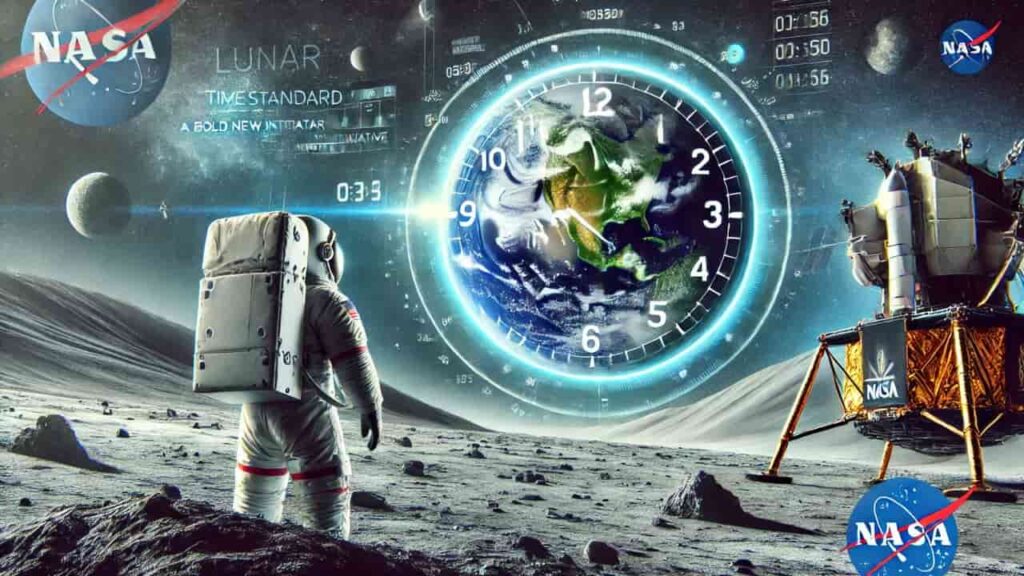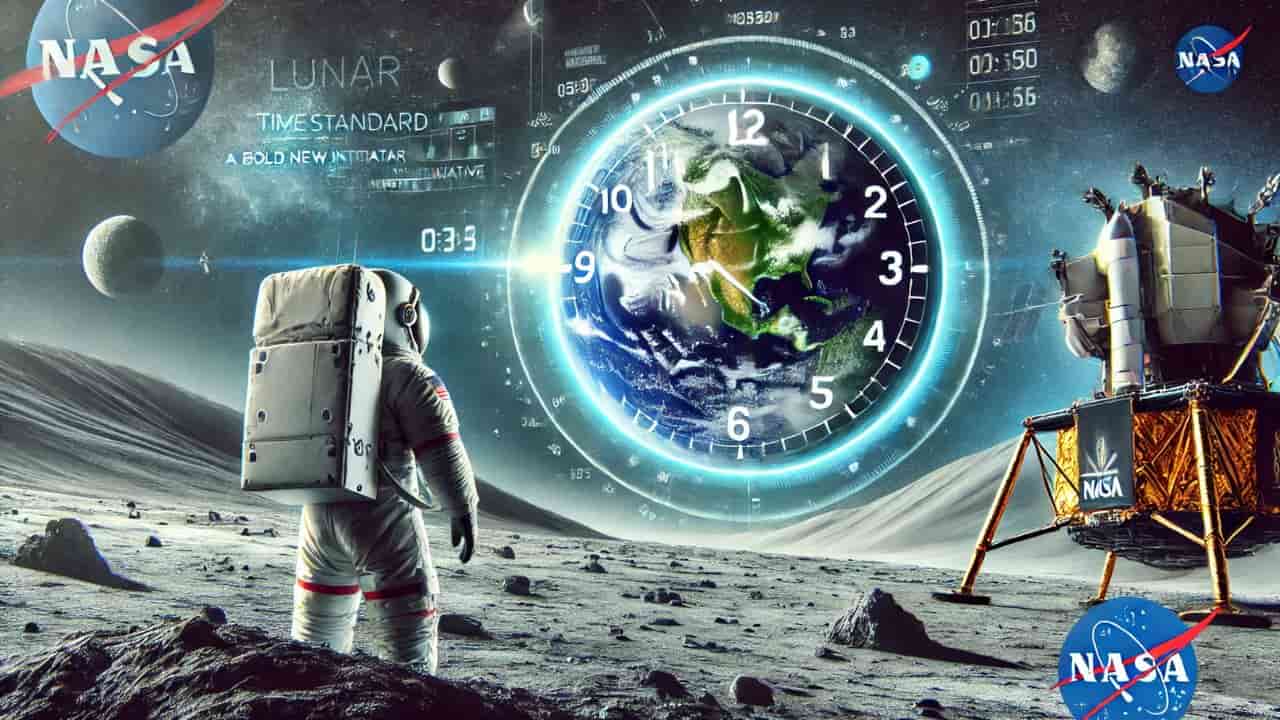NASA, Lunar Time Standard, Coordinated Lunar Time, Artemis program, Moon timekeeping, space exploration, atomic clocks, lunar navigation, space communication, SCaN program, Moon missions, international space collaboration
Discover how NASA is developing a Coordinated Lunar Time (LTC) for future Moon missions. Learn about the importance of accurate timekeeping in space, its role in the Artemis program, and the global collaboration behind this groundbreaking initiative.

NASA to Develop a Lunar Time Standard for Exploration Initiatives
In April 2024, the White House issued a policy directive that tasked NASA with developing a coordinated lunar time standard. This bold initiative aims to establish a unified timekeeping system for the Moon, similar to Earth’s Coordinated Universal Time (UTC), which could eventually scale to other celestial bodies like Mars. NASA’s Space Communication and Navigation (SCaN) program has taken the lead in this project, working closely with U.S. government stakeholders, international partners, and standards organizations.
The creation of a Coordinated Lunar Time (LTC) is critical for the success of NASA’s future lunar missions, especially as the Artemis program gears up to establish a permanent human presence on the Moon. A common time system will ensure that astronauts, researchers, and various spacefaring nations can collaborate effectively in lunar exploration without discrepancies in timekeeping affecting mission safety and communication.
Why Is Lunar Time Needed?
As space exploration advances, establishing a lunar time standard becomes a necessity rather than a luxury. Currently, astronauts and robotic missions on the Moon rely on Earth-based time systems. However, as missions become more frequent and complex, the limitations of using Earth time in lunar operations become more apparent. A dedicated time standard for the Moon will help synchronize operations, ranging from communications to navigation and data collection.
Consider that atomic clocks on the Moon will experience time differently due to relativistic effects. NASA’s initial research shows that atomic clocks on the lunar surface will appear to “tick” faster by microseconds per day than they would on Earth. Though a microsecond is only one millionth of a second, even such minute differences can compound over time, affecting navigation and communication systems that rely on precise time measurements. For example, a 56-microsecond discrepancy could cause an astronaut orbiting the Moon to be perceived as 168 football fields away from their actual location by an observer on Earth.
Dr. Cheryl Gramling, who leads NASA’s lunar position, navigation, timing, and standards at NASA Headquarters, underscores the importance of accurate timekeeping: “For something traveling at the speed of light, 56 microseconds is enough time to travel the distance of approximately 168 football fields. If someone is orbiting the Moon, an observer on Earth who isn’t compensating for the effects of relativity over a day would think that the orbiting astronaut is approximately 168 football fields away from where the astronaut really is.”
The Role of Atomic Clocks
The lunar time system will likely rely on highly accurate atomic clocks, much like Earth’s UTC system. Atomic clocks work by measuring the vibrations of atoms—specifically cesium or rubidium atoms—which provide an incredibly precise measure of time. The clocks on the Moon will be synchronized with clocks on Earth to maintain a unified time system, despite the differences in gravitational forces between the two celestial bodies.
One of the key challenges NASA faces is determining where on the Moon these atomic clocks will be located, as their performance could vary based on their position. NASA and its partners are actively researching which mathematical models and technologies will best support the creation of a lunar time standard that accounts for these differences.
Establishing a lunar time system will not only benefit NASA but also commercial space companies, other space agencies, and international partners that are planning lunar missions. As more actors become involved in lunar exploration, having a standardized time will ensure safety, coordination, and sustainability. It will allow spacecraft, rovers, and astronauts to operate without the risk of time discrepancies that could lead to navigational errors or communication breakdowns.
Artemis and the Future of Lunar Exploration
NASA’s Artemis program aims to return humans to the Moon by 2025 and establish a long-term presence on and around the lunar surface. This will include setting up lunar bases, conducting scientific research, and developing the infrastructure needed for future missions to Mars and beyond. With this increase in activity, the need for a dedicated lunar time standard becomes even more critical.
A lunar time system will serve as a foundation for many aspects of lunar operations, including communication between Earth and the Moon, navigation of spacecraft and rovers, and synchronization of scientific experiments. It will also enable the integration of data from various international missions and private companies working on the Moon.
NASA’s SCaN program, which is responsible for space communication and navigation, will be crucial in this effort. SCaN currently supports over 100 missions, including those on the International Space Station and future Artemis missions. It operates through two networks: the Near Space Network and the Deep Space Network, both of which are critical for ensuring reliable communication and navigation across vast distances.
The SCaN program will use its expertise to develop the systems and technologies needed to create a lunar time standard. This will include collaborating with international partners and commercial companies, as well as working with standards organizations to ensure that the lunar time system is widely accepted and used.
Relativity and Lunar Time
The creation of lunar time brings up fascinating questions about the nature of time itself. Time on the Moon moves differently than on Earth due to the phenomenon of time dilation, which is explained by Einstein’s theory of relativity. Time dilation occurs because the Moon has a weaker gravitational pull than Earth, causing time to pass slightly faster on the lunar surface than it does on Earth. While the difference is only a few microseconds per day, it can become significant when dealing with precise measurements, such as those required for space navigation.
To compensate for this, NASA and its partners are developing mathematical models that will take into account the effects of relativity. These models will help synchronize lunar clocks with Earth clocks, ensuring that time is measured accurately across both celestial bodies.
This work will not only benefit lunar exploration but could also be applied to other planets and moons in our solar system. As NASA looks toward future missions to Mars, the experience gained from developing a lunar time system will provide valuable insights into how to establish a timekeeping system for other planets.
Global Cooperation in Space Timekeeping
NASA’s efforts to establish a lunar time standard are part of a broader trend toward increased international cooperation in space exploration. As more countries and private companies develop their own lunar missions, having a shared time system will be essential for ensuring smooth and coordinated operations. NASA is working closely with its international partners, including the European Space Agency (ESA), to develop a system that can be used by everyone involved in lunar exploration.
Dr. Ben Ashman, navigation lead for lunar relay development at NASA’s SCaN program, emphasized the importance of time standardization: “As the commercial space industry grows and more nations are active at the Moon, there is a greater need for time standardization. A shared definition of time is an important part of safe, resilient, and sustainable operations.”
This level of international collaboration is unprecedented in space exploration, and it reflects the growing recognition that the Moon is a shared resource. By working together to create a lunar time standard, NASA and its partners are laying the groundwork for future cooperation in space exploration, not just on the Moon but throughout the solar system.
Scalability to Other Celestial Bodies
While the immediate focus is on developing a time standard for the Moon, NASA is also looking ahead to future exploration initiatives on Mars and other celestial bodies. The time system developed for the Moon could serve as a model for timekeeping on other planets, providing a scalable solution for interplanetary exploration.
As humanity continues to explore space, having a coordinated time system will become increasingly important. Time is not just a way of keeping track of hours and minutes; it is a fundamental part of how we navigate and communicate across vast distances. By establishing a lunar time standard, NASA is taking a critical step toward enabling long-term human exploration of the Moon, Mars, and beyond.
Conclusion
NASA’s initiative to develop a lunar time standard is a crucial component of its broader efforts to establish a sustained presence on the Moon and explore other planets. By working with international partners and leveraging advanced technologies like atomic clocks, NASA is paving the way for a future where timekeeping in space is as precise and reliable as it is on Earth. As the Artemis program moves forward and more nations and companies join in lunar exploration, having a standardized lunar time system will ensure that everyone can operate safely and efficiently. This bold initiative marks another milestone in humanity’s journey to explore the stars.
Read More
- NASA Astronaut Don Pettit and Crewmates Arrive at the International Space Station for Expedition 71/72
- SpaceXs New Falcon 9 Booster Successfully Launches 22 Starlink Satellites Boosting Global Connectivity
- Everything You Need to Know About the Full Sturgeon Moon 2024 August Supermoon Viewing Guide
- NASA and Sierra Space Dream Chaser Arrives in Florida for Launch Prep










